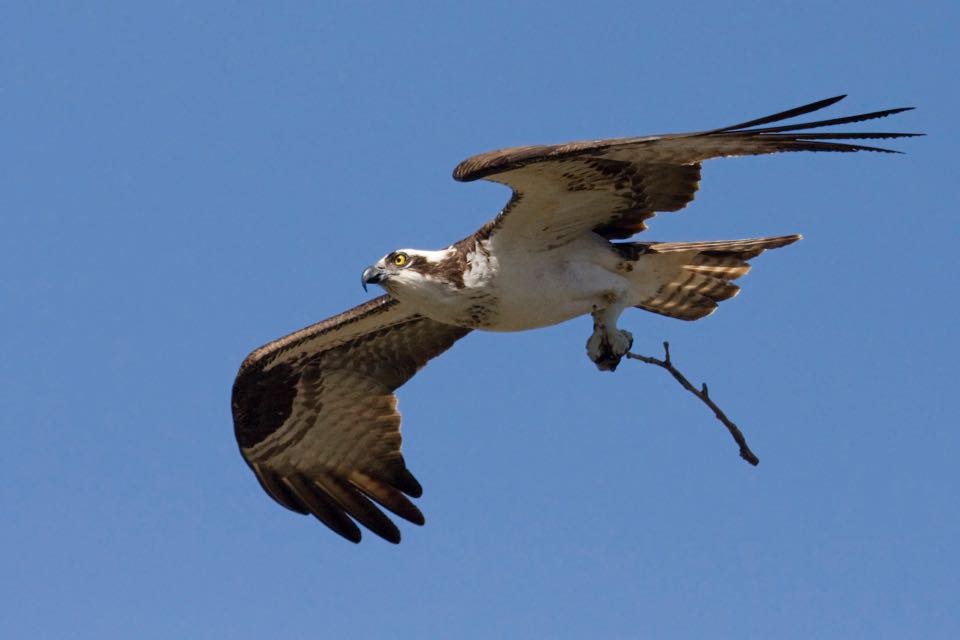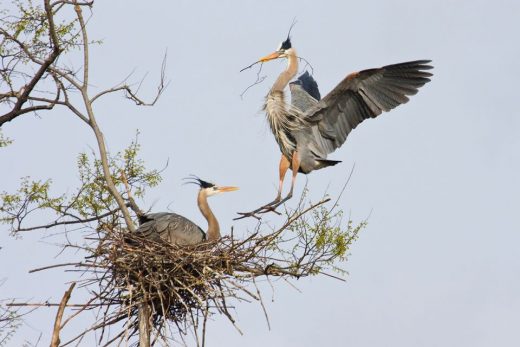By Ashley Peele/Kurt Gaskill

Osprey with stick at Richmond Rookery (CO Bob Schamerhorn)
Check out this great Atlas advice article contributed by Kurt Gaskill, a volunteer coordinator for Atlas region 2. He shares some Atlas tips gleaned not just from his participation in the VABBA2, but also from his experiences in the first VA Breeding Bird Atlas. Spend those cold rainy afternoons reviewing your data and getting excited for our final Field season!
The third year of Virginia’s Breeding Bird Atlas 2 has ended and year four is just beginning – as of December 15 Great Horned Owls became fair game. And the third year was a great year for the Atlas as 135 blocks are now complete. There are some great new breeding confirmations not found in the first Atlas such as Common Merganser, Anhinga, Ruby-crowned Kinglet, Yellow-rumped Warbler, and Painted Bunting! Yet, there are so many other priority blocks and species that need attention. Now, perhaps like you, I am developing plans for this coming breeding season. So, I look over Atlas data to develop my species strategy and…wait…I put down Blue Jay as singing? Rookie mistake!!! Arghhh!
Yep, all of us do it on occasion. Those little Atlas coding mistakes slip by. It wasn’t intentional. I was probably a bit busy when I entered the data into the Atlas portal. Or maybe just tired. I can always go back and change the obvious mistakes – once I find the time! So, to help me (and maybe you) save time in the future, here is a list of Common Atlas Boo-boos.
1. All the species observed are not coded on a trip list. This happens more often then you may think; you visit a block but neglect to code some or all the species you see. For example, you may think ‘these are common species and someone else has done it.’ But occasionally, the species remains un-coded for the block, which means these are listed as “observed” and never upgraded to a possible breeder. Since you, the observer, are the only person who can add a code, this means all your effort to find, identify, and report that species is lost for the purposes of the breeding bird Atlas!
2. Coding a species that is migrating. This happens often and is an easy mistake to make. To avoid this, you should consult the VABBA2’s Breeding Guidelines Bar Charts to determine the “safe” data range for coding a potential breeding species. Of course, sometimes species exhibit behaviors that confirm breeding, before the safe date range starts or ends examples of such behaviors are nest building (B or NB codes) and obviously fledged birds (FL). If you observe these types of situations outside the safe date range, you should add a statement in the notes section of your eBird checklist to clarify why you are justified in coding the species outside of the safe dates.
3. Incorrect use of the T code. This code is for a breeding species that exhibits physical behaviors to defend its breeding area. It can be directed toward another of its own species (e.g., chasing it) or going after a predatory bird (chasing or harassing hawks, Blue Jays, Ravens, Crows, vultures). To illustrate, a bird singing from perch to perch should not be assigned a T code, but instead consider the S, S7, C, A, or N codes. However, a bird that is actively chasing another can be coded as T.
4. Recording the “Pair” code for species where the sexes look alike without explanation. Upon annual review of the Atlas data, these observations will nearly all be “reinterpreted”, and the code will be downgraded. That is because it is very difficult to explain why two identical birds are male and female. Consider using a more appropriate code such as S, S7, C, A, T or N.
5. Coding Great Blue Herons, Great Egrets, larids, Double-crested Cormorants and other colonial nesting species as possible or probable breeders. At this time, colonial nesters must be in a known breeding block (i.e. one with a known nesting colony) to support a probable or possible code, otherwise the sighting should be listed as a flyover or just observed.

Great Blue Herons (CO Bob Schamerhorn)
6. Coding woodpeckers, nuthatches, and corvids as S for singing or even S7. The vocalizations of these birds are not considered song and so the S or S7 designation cannot be used; instead the appropriate habitat code, H should be used. The loophole is for woodpecker drumming: drumming of woodpeckers is considered advertisement in the same way that song is, and that behavior can be coded as S and, in principle, S7 a week or more later if the same bird is drumming.
7. Coding a Raptor carrying food as CF. Since raptors can fly long distances, into adjacent blocks (or further if still migrating) you cannot use the CF code unless there are special circumstances. If you believe the circumstances warrant the CF coding, then you should provide justification for this on the checklist notes.
8. Coding raptors and herons carrying sticks as CN. Since many representatives of these species can carry sticks and other nesting material long distances, you should insure that the target bird lands and is nest building in the target block. If it flies out of sight with a stick, how do you know where it is landing to build? It could be miles away!
9. Using the M code. The Virginia Breeding Bird Atlas 2 does not use the M code – through a glitch by E-bird, this code shows up on the E-bird portal and, when you convert the sighting to the Atlas portal, it persists. If you enter directly through the Atlas portal, you will not see M as an option. During the review process, the M code gets downgraded to Singing Male (S), which may be a code that is less than your observation merits, so be sure to avoid using M!
10. Reporting observations in the Atlas with no breeding information. This often happens after the breeding season effectively ends in September. Using the Atlas portal, the observer reports a list of species, but no breeding information is present because it is the off-season and no birds are presently engaged in breeding activity. This skews the Atlas data for the block and the state on effort hours. If you have no breeding information, i.e., you are not adding a code, then you should not use the Atlas portal and instead use the regular E-bird portal (found at ebird.org). **One exception to this rule are nocturnal checklists focused on finding breeding owls. These lists may be logged over the winter when nothing but owls are breeding. If no owls are detected, this may look like a pretty empty list, but volunteers can still log these here to the Atlas eBird portal.
But, even knowing the Boo-boos, I (and maybe you) still make a few. So, when I have some time, especially on these rainy, winter days, I go into my lists through the Atlas portal and correct mistakes. Its not that hard…and it sometimes evokes pleasant thoughts of a fun birding day several months ago!
Lastly, let me suggest that since vultures are a somewhat special case for recording as potential breeders, you should provide a short statement as to why you are reporting a breeding code. In general, a flying vulture cannot be assigned a code except for F (and even then, don’t feel compelled to code every vulture you see as F; once per block is sufficient.)
Virginia’s Breeding Bird Atlas 2 portal can be found at: https://ebird.org/atlasva/home
Thank You and Wishing You Successful Atlas Adventures!
P.S. Kurt Gaskill is coordinating the Northern Region (Atlas Region 2) for VA Breeding Bird Atlas 2 and if you have any questions about Atlas activities in this area, please feel free to drop him a note.
Don’t forget about the Atlas Facebook Group, where you can also post questions, share sightings, and interact with other active Atlas volunteers from across Virginia – https://www.facebook.com/groups/VABBA2/

